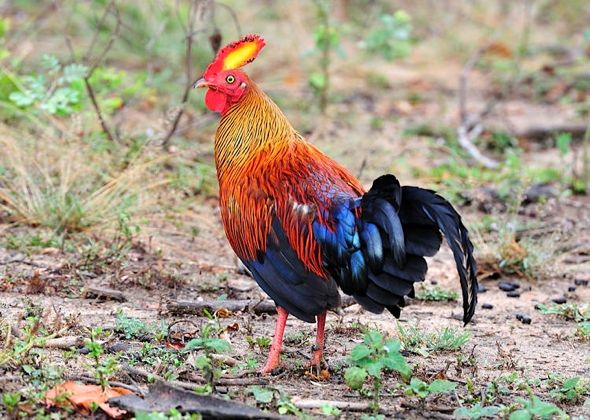Sri Lankan Jungle Fowl / Ceylon Jungle Fowl (Gallus lafayetii)
Known during the colonial era as the Ceylon Jungle Fowl, the Sri Lankan Jungle Fowl is endemic to the island and is also the national bird of Sri Lanka.
In Sinhala it is known as Walikukula. As with other junglefowl, the Sri Lankan Junglefowl is strongly sexually dimorphic: the male is much larger than the female,
with more vivid plumage and a highly exaggerated wattle and comb.
The male Sri Lankan Juglefowl ranges from 66-73 cm (26-29 in) in length and 790-1,140 g (1.7-2.5 lb) in weight, essentially resembling a large muscular rooster. The male has orange-red body plumage, and dark purple to black wings and tail. The feathers of the mane descending from head to base of spine are golden and the face has bare red skin and wattles. The comb is red with a yellow centre. As with the Green Junglefowl, the cock does not possess an eclipse plumage.
The female is much smaller, at only 35 cm (14 in) in length and 510-645 g (1.1-1.42 lb) in weight, with dull brown plumage with white patterning on the lower belly and breast, ideal camouflage for a nesting bird.
The Sri Lankan Junglefowl is most closely related to the Green Junglefowl, though physically it resembles the Grey Junglefowl and the Red Junglefowl. Like the Green Junglefowl, Sri Lankan Junglefowl are island species that have evolved side by side with their similarly stranded island predators and competitors. As with most other pheasants, Sri Lanka Junglefowl is a teresstrial species. It spends most of its time foraging for food by scratching the ground for various seeds, fallen fruit and insects. It is a ground nesting bird, and lays 2-4 eggs in a nest. Similar to many members of the pheasant family, the colourful male plays no part in the incubation of the eggs or rearing of the young.

The male Sri Lankan Juglefowl ranges from 66-73 cm (26-29 in) in length and 790-1,140 g (1.7-2.5 lb) in weight, essentially resembling a large muscular rooster. The male has orange-red body plumage, and dark purple to black wings and tail. The feathers of the mane descending from head to base of spine are golden and the face has bare red skin and wattles. The comb is red with a yellow centre. As with the Green Junglefowl, the cock does not possess an eclipse plumage.
The female is much smaller, at only 35 cm (14 in) in length and 510-645 g (1.1-1.42 lb) in weight, with dull brown plumage with white patterning on the lower belly and breast, ideal camouflage for a nesting bird.
The Sri Lankan Junglefowl is most closely related to the Green Junglefowl, though physically it resembles the Grey Junglefowl and the Red Junglefowl. Like the Green Junglefowl, Sri Lankan Junglefowl are island species that have evolved side by side with their similarly stranded island predators and competitors. As with most other pheasants, Sri Lanka Junglefowl is a teresstrial species. It spends most of its time foraging for food by scratching the ground for various seeds, fallen fruit and insects. It is a ground nesting bird, and lays 2-4 eggs in a nest. Similar to many members of the pheasant family, the colourful male plays no part in the incubation of the eggs or rearing of the young.


